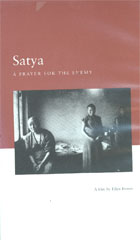
Satya: A Prayer for the Enemy 1993
Distributed by The Film Library, 190 Route 17M, P.O. Box 1084, Harriman, NY 10926; 800-343-5540
Produced by Ellen Bruno
Directed by Ellen Bruno
VHS, color, 28 min.
Jr. High - Adult
Religious Studies, Asian Studies, Human Rights, History
Date Entered: 10/25/2005
Reviewed by Paul Moeller, University of Colorado at BoulderIn her documentary, Satya a Prayer for the Enemy, Ellen Bruno briefly examines how the situation for Tibetan nuns and monks has changed since China took control of Tibet in 1950 by examining a resistance movement lead by Buddhist nuns. The nuns took to the streets in non-violent protest in response to steps the Chinese had taken to assert control over the region. These steps included the imposition of communism, the destruction of temples, and the forced withdrawal of nuns and monks from religious life. Even though the nuns feared that open protest would engender a severe response from the Chinese they chose to lead the protests because they felt they had less to lose than their lay countrymen. When the nuns rose up in protest many monks and lay people joined in. The Chinese response was violent and many were shot. Others were later raped or otherwise tortured for their involvement in the protest.
Through the words of surviving nuns Bruno effectively tells of their attempt to promote human rights and freedom for Tibetans with peaceful protest. Bruno pays close attention to the motivations of these courageous women. The stories they have to tell are thought provoking and they should serve well as focus points for discussion. Questions about freedom of religion and the nature of Chinese rule in Tibet readily come to mind after viewing this documentary. Students of politics may also consider China’s relations with other nations in light of their actions in Tibet. Satya a Prayer for the Enemy should be of value to those with an interest in Tibet, human rights, and religious freedom. It is highly recommended for viewers from Jr. High through adults and to the libraries that serve them.